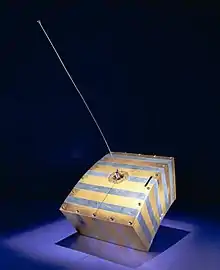 OSCAR 2 | |
| Mission type | Communications |
|---|---|
| Operator | Project OSCAR / DoD |
| Harvard designation | 1962 Chi 1 |
| COSPAR ID | 1962-022B |
| SATCAT no. | 305 |
| Mission duration | 22 days |
| Spacecraft properties | |
| Launch mass | 10.0 kilograms (22.0 lb) |
| Dimensions | 15.2 by 25.4 by 33 centimeters (6.0 in × 10.0 in × 13.0 in) |
| Start of mission | |
| Launch date | 2 June 1962, 00:43 UTC |
| Rocket | Thor DM-21 Agena-B |
| Launch site | Vandenberg LC-75-3-4 |
| End of mission | |
| Decay date | 21 June 1962 |
| Orbital parameters | |
| Reference system | Geocentric |
| Regime | Low Earth |
| Eccentricity | 0.01399 |
| Perigee altitude | 207 kilometers (129 mi) |
| Apogee altitude | 394 kilometers (245 mi) |
| Inclination | 101.00 degrees |
| Period | 90.5 minutes |
OSCAR 2 is the second amateur radio satellite launched by Project OSCAR into Low Earth orbit. OSCAR 2 was launched June 2, 1962, by a Thor-DM21 Agena B launcher from Vandenberg Air Force Base, Lompoc, California. The satellite, a rectangular box (30 cm × 25 cm × 12 cm (11.8 in × 9.8 in × 4.7 in)) weighing 10 kg (22 lb), was launched as a secondary payload (ballast) for Corona 43, the fifth launch of a KH-4 satellite.
The satellite employed a monopole transmitting antenna 60 cm (24 in) long extended from the center of the convex surface, but had no attitude control system. OSCAR 2 lasted 18 days, ceasing operation on June 20, 1962, and re-entered June 21, 1962.[1][2]
OSCAR 2 incorporated certain design changes from the earlier OSCAR 1.[2]
See also
References
![]() This article incorporates public domain material from websites or documents of the National Aeronautics and Space Administration.
This article incorporates public domain material from websites or documents of the National Aeronautics and Space Administration.
